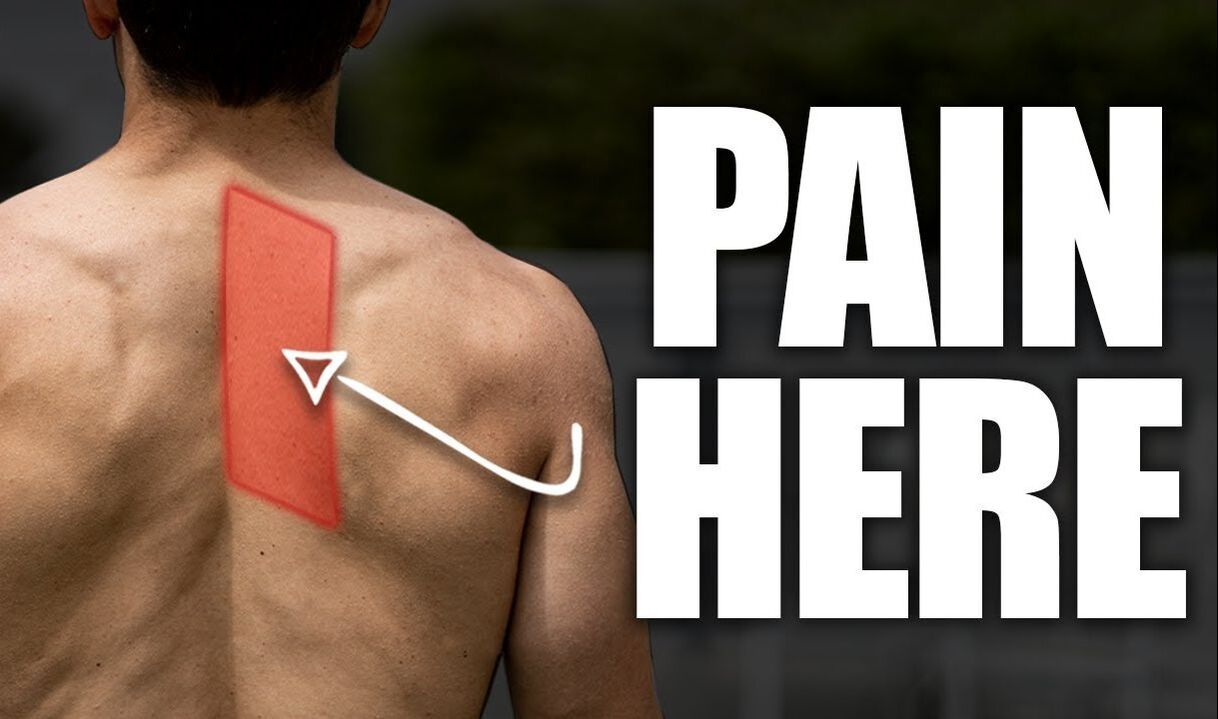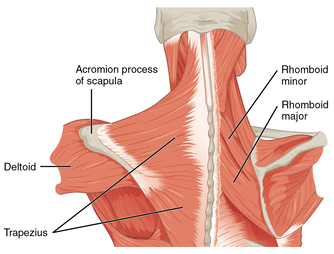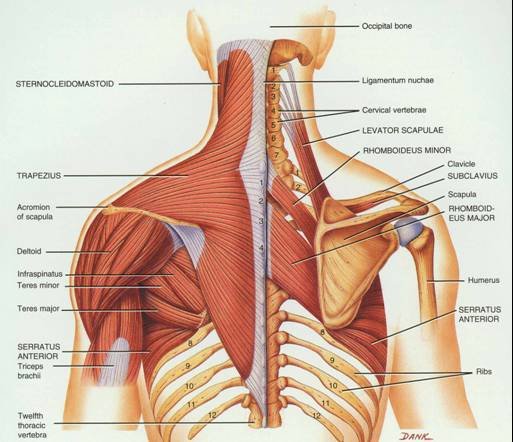|
Do you, or have you ever experienced a niggling pain between your shoulder blades and spine? It can potentially reoccur frequently and last a few days or may be more persistent. Whatever the presentation I'm not here to tell you what the cause is because the bottom line is there could be multiple reasons why you have this pain. I’m here to try and give you an understanding of what are the potential causing factors and some strategies to address this. What muscles are near this area? Pain in this region may be called rhomboid pain, the reason being is because both rhomboid minor and major live here (refer to the above image). Both the rhomboid muscles originate on the spine and insert on the medial border of the scapula (inside edge of the shoulder blade). The action of the rhomboids is to retract the scapula (bring the shoulder blades together) and downwards rotate the scapula (like when you bring the arm down from an overhead position). The trapezius muscle is another in this area and is closer to the skin than the rhomboids (see picture above). These two muscles, along with many others, help to move the scapula with the arm to allow for efficient movement when performing your daily task or exercise. Let's not point the finger too soon. The body moves with an interplay of different systems and structures which rely on each other for efficient movement. When a change to a system or structure happens it may create a problem for another close by in the body. Just because the pain is in between the spine and the shoulder blade, does not mean the rhomboids are the reason for your pain, and even if the rhomboids are in pain they may not be the cause. The body moves with an interplay of different systems and structures which rely on each other for efficient movement. When a change to a system or structure happens it may create a problem for another close by in the body. Let's have a look at what other structures are in the same area or close by including:
It is a bit overwhelming when you look at a picture such as above of just the bones and muscles in this area. However, although there are a large number of potential causes and contributors, we know that improving thoracic mobility can help to improve this nagging pain in your back. Therefore, without being able to individualise a treatment plan on a blog I thought I would give you some exercises to try out! Focusing on thoracic mobility and optimising ( if we know what optimal is) shoulder blade movement. Exercises promoting thoracic mobility Mobility means the ability of a joint to move or be moved freely and easily. With that being said, the thoracic spine is made to be able to move in all different directions, so we need to help it move in all different directions! Two movements that people may tend to require more work in are rotation and extension. Thoracic Rotation Thoracic Extension Excuse my poor thoracic extension!! Exercise promoting shoulder blade movement Movement of the shoulder blade depends on a variety of muscles and although it is unclear what the role of shoulder blade movement on pain and dysfunction is, we can't deny getting the shoulder blade moving and allowing each muscle to do their job is going to be of benefit. One particular muscle that you may benefit from getting moving is the serratus anterior, which lies between the shoulder blade and the rib cage and is responsible for upward rotation (helping the shoulder blade move when you put your arm over head) and protraction (moving your shoulder blades away from each other). Helping the serratus anterior Some tips to remember
If you have this mid back pain, the bottom line is to keep moving! We want to be more mobile and want to minimise the time you sit in one posture. Movement is medicine! Remember this is just general advice! If you are after something more specific Come in and see one of our Exercise Physiologists. Izaac Boylan Accredited Exercise Physiologist
0 Comments
COVID-19 is becoming increasingly prevalent both within our local community and the broader population and it is more than likely at this stage that either you or someone you know has contracted the virus. Find out everything you need to know about returning to exercise after a bout of COVID-19. So... How can COVID-19 affect my ability to exercise? Everyone has different experiences after contracting COVID-19 and this can all be related to your age, gender, overall health and symptom severity. You may initially experience symptoms such as a persistent cough, shortness of breath, fatigue, headaches, body aches, nausea or a sore throat, all of which will impact your ability to exercise. Furthermore if you experience “long-COVID” where symptoms persist for several weeks after having the virus, you may present with inflamed lungs causing significant shortness of breath or high levels of fatigue. These will both limit your physical function and capacity to complete moderate to vigorous intensity exercise. Should I exercise if I have COVID-19? The short answer is no. Research completed by the World Health Organisation tells us that up to 40% of people who contract COVID-19 will be asymptomatic and generally feel fine. If this is the case the recommendation is to complete light movement such as gentle walking or stretching but to avoid moderate to vigorous exercise. For those who do display symptoms of COVID-19 and feel unwell it is advised to rest, increase fluids and complete very gentle movement as even a short walk down the hallway can aggravate shortness of breath in some people. How long should I wait before returning to exercise? There is no one size fits all in regards to this question as recovery from COVID-19 will look different for everyone. Initially being cautious not to spread the virus to others when in the acute stage and presenting with symptoms. This means staying away from gyms, group exercise classes or team sports. Start small and gradually build up, try to think of any daily movement as a form of exercise and increase from there. For example doing a few walks up and down the hallway and stopping once you begin to feel uncomfortable. Exercise has been shown to increase stimulation of the immune system, assisting you to recover from COVID-19. Although be-mindful that mild symptoms can persist up to 6 weeks so it is important to listen to your body and rest when needed, when returning to exercise. How will I know if I am doing too much? It is important to listen to your body and be aware of what are “normal” signs and symptoms when exercising and what are not. For example it is “normal” to have some degree of shortness of breath and fatigue when exercising. It is NOT normal to have these symptoms when doing gentle, everyday activities that you could previously do with ease. The amount of time you had off from your regular exercise routine is also important to consider. After any period off from our regular exercise routine we need to regress exercises to adjust for our decreased strength and cardiovascular endurance. This may involve reducing the time or distance that you are completing during your cardio or the weight, repetitions or number of sets during strength based exercises. Lastly monitoring your symptoms after exercise and the next day will guide you in knowing if you are doing too much and need to slow down a little bit or if your body is responding well to your volume of exercise. If you are recovering from COVID-19 and not sure where to start when getting back into exercise, one of our Exercise Physiologists can assist you in this process, in a safe and individualised manner. Written by,
Aleisha Michael Accredited Exercise Physiologist |
AuthorSLisa Parkinson Archives
July 2024
Categories
All
|






 RSS Feed
RSS Feed